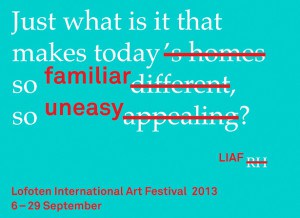Just what is it that makes today so familiar, so uneasy?
6–29 September 2013
Lofoten International Art Festival 2013
Curated by Anne Szefer Karlsen, Bassam El Baroni and Eva González-Sancho
By rephrasing the title of Richard Hamilton’s famous collage Just what is it that makes today’s homes so different, so appealing? (1956), LIAF 2013 aims to explore a shift that can be described as one from a condition of successive crises followed by recoveries, to one where crises shape a new permanent condition. It is a question prompted by our present that seems to be stuck in a continuous loop, in which the predominant ideas that have shaped our world are unsustainable and unimaginative when it comes to solving everyday problems people face in most parts of the world.
Despite slight changes, and perhaps even small improvements, no practical alternatives have yet appeared to challenge these ideas, thus causing a worldwide state of limbo in socio-economic life. The uneasiness in our day-to-day existence appears most strikingly in the form of antagonisms, strong and sometimes violent disagreements between people, people and their governments, people and political ideologies.
Acknowledging the culture of art as an integrated part of society, crises can also be traced within an increasingly institutionalised sphere of the arts. However, the antagonisms induced by these crises are not identical to the ones we see in society at large. Bridged by a diversified media-scape, our current condition has made evident that the professional antagonisms of art constructed for the betterment of society are conditioned differently than the amateur antagonisms that are forced to the fore by injustices in society.
The curatorial attitude of LIAF 2013 aims to create a reflection on how art can position itself as a profession and as a vocabulary within societies in which the protocol of contemporary institutional art practice is built on the idea of instigating, designing, or manufacturing some form of antagonism through its programming. The scarcity of art institutional structures in Lofoten offers LIAF 2013 an opportunity to seriously consider the conditions described above, immersing itself in the fabric of the local community, its domestic, commercial and public spaces while exploring the current moment’s global uneasiness.
Just what is it that makes today so familiar, so uneasy? intends to establish an aesthetic, intellectual, and political position by bringing the public and those shaping contemporary art discourse closer to a heightened and sensitive understanding of the conditions that shape our consciousness and existence today. LIAF 2013 will feature a balanced variety of art projects that create connections with each other and their surroundings, forming a circuit of intense emotions, ideas, and positions. Additionally, great attention will be given to mediation, intensifying the project’s impact within its locale.
On 30 May LIAF 2013 contributes to ‘Perspectives beyond stagnation,’ a breakfast forum with Gopal Balakrishnan and Aaron Schuster, in collaboration with the Central Asian Pavilion 2013 at the 55th International Art Exhibition la Biennale di Venezia.
Just what is it that makes today so familiar, so uneasy? will be on view in the two centres of Vågan Municipality, Svolvær and Kabelvåg. Many of the works will be specially commissioned for LIAF 2013—some of which will also be of a site-specific nature. LIAF 2013 will be accompanied by a bilingual guidebook and a seminar on 7 September. A publication, which will position LIAF 2013 within the larger international context, will be printed at a later stage.


